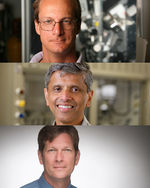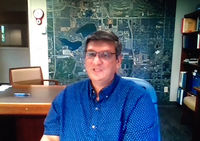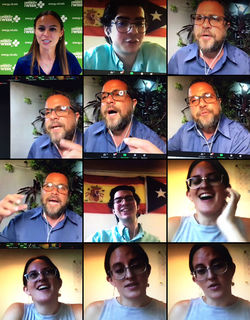2020 Recap


The 14th annual Notre Dame Energy Week was held as a series of virtual events from August 23 to August 28, 2020. Sponsored by ND Energy and its Student Energy Board, events were hosted by Ginger E. Sigmon, ND Energy’s managing director. The theme throughout the week centered on environmental justice with a focus on improving the health, prosperity, and resiliency of our planet for generations to come.
2040 Documentary

The week kicked off on Sunday, August 23, with an exclusive online screening of the informative and forward-looking documentary, 2040. Award-winning director Damon Gameau took viewers on a journey of "fact-based dreaming" to envision a better world. While circling the globe, he focused on solutions by embracing what exists today, starting in Bangladesh where bottom-up systems are used to develop reliable, affordable, and decentralized grids for communities, to New York City where on-demand driverless vehicles will lead to more green space, urban food farms, and regrowth in manufacturing, to Australia where planting a variety of plants can pull CO2 from the atmosphere into the soil to make it healthier and give way to natural livestock grazing and industrial agriculture, to Massachusetts where oceans will regenerate themselves to restore fish habitat and generate more seaweed for food, animals, and biofuels.
Through this, the Notre Dame community imagined a world in 2040 where climate change has been sharply curtailed and the Regeneration Movement, steeped in urgency to act now, successfully preserves the earth for future generations.
ND Energy Bouts … Fighting for Renewable Energy

Stepping into the ring on August 24 for the second annual ND Energy Bouts, reigning champion Prashant V. Kamat, Rev. John A. Zahm, C.S.C., Professor of Science in Chemistry and Biochemistry, put his title belt on the line against challengers Peter C. Burns, Henry Massman Professor of Civil & Environmental Engineering & Earth Sciences, and Scott C. Morris, professor of aerospace and mechanical engineering.
Representing solar, Kamat threw the first punches of the night. He advocated for the emergence of perovskite solar cells, touting the rapid improvements in efficiency and cost for the technology, as well as the flexibility for independent power and the ability to provide 25% of the world’s energy needs cost-effectively.
Burns asserted that nuclear energy was the “moral imperative” for combating the challenge of climate change, as it is more about saving the planet; not about saving money. Using the example of the United States Navy, he promoted the concept of small, modular reactors as the only existing option to immediately replace fossil fuels. These small reactors would have enough fuel to provide energy that lasts 24 hours a day, 7 days a week, and 365 days per year for 20 years. The only maintenance would be refueling them.

Drawing contrasts to the other two sources, Morris argued that wind has the potential to meet industrial level energy demands both cost-effectively and safely without using water, producing waste, or consuming large swaths of land. Acknowledging storage as the final obstacle for the widespread implementation of wind energy, he asked that this area be the focus of the audience’s investment.
Following numerous rebuttals and questions from the audience, Burns emerged as the new ND Energy Champion, victoriously receiving 44 percent of the vote, avenging his narrow one-point loss to Kamat in the previous match. Morris and wind energy finished second with 35 percent, while Kamat finished in third with 21 percent.
Notre Dame’s Energy Future … Growing Greener

On Tuesday August 25, Paul Kempf, assistant vice president for utilities and maintenance, gave an annual update on Notre Dame’s move toward de-carbonization. Kempf highlighted Notre Dame’s strategy for powering campus facilities while maintaining its long range plan to diversify and be flexible. Using a combination of measures, including energy conservation, fuel switching, combined heat and power, renewable energy, recoverable energy, and purchased power, Notre Dame achieved its goal this year to reduce carbon emissions by 50%, ten years earlier than projected. Kempf also recalled October 14, 2019, which was the day Notre Dame stopped using coal.
Kempf then detailed the ongoing construction of the hydroelectric generation facility in downtown South Bend and the newest partnership with Indiana Michigan Power to develop the St. Joseph Solar Farm, a planned 20-megawatt solar array northeast of campus. Both facilities will account for 27 percent of the University’s current purchased power.
Currently, Notre Dame remains well ahead of its benchmarks for reduction of carbon emissions by 2050. Kempf gave a glimpse at potential paths the University’s Utilities Long Range Plan could take based on capital investments, including the possibility of becoming carbon neutral.

Wednesday night’s presentation featured former Notre Dame professor Patrick Regan and his business partner Marty Whalen, who shared the early successes and unexpected challenges of establishing Crossroads Solar, a solar panel manufacturing company that employs and trains former convicted felons to fulfill its mission of providing clean energy solutions for domestic customers.
Pat’s main aspiration is to give back to the community and Crossroads Solar fulfills this dream. It is more of a social enterprise that uses a triple P bottom line approach of People, Planet, and Profit, in that order. Employees are given a chance to turn their lives around by earning a decent wage, learning a new trade, and contributing to the mitigation of climate change.
The four undergraduate students, James Hegarty, Sylvia Kolda, Kelly Moran, and Erin Ludwig, who helped Pat prepare the factory for production during the summer showed a video of how the assembly unfolded. They then discussed their experience working as a team, each using their own unique talents to build machines, test operations, and develop training tools, while gaining a deeper understanding of solar energy. They all agreed that by overcoming their initial fears of not being able to do something new, they soon became the “perfect team of engineers.”
Some students will continue assisting Pat through the academic year and others were welcomed to get involved through internships, touring the facility, and staying connected by signing up for the Crossroads Solar newsletter.
The Future of Mobility … Tough Choices Ahead

In partnership with Notre Dame’s Net Impact Club, ND Energy hosted three experts from the transportation industry for a panel discussion on the future of mobility. The panel was moderated by Jonathan George, Mendoza MBA student and president of Net Impact.
Matt Peak, managing director of Energy Systems Network, outlined a move toward electrified, automated, and shared transportation options as alternatives to automobiles. Michael Noland, president and general manager of the South Shore Line, described current initiatives to improve connectivity between Chicago and Northern Indiana, anticipating that electric rail cars will be automated in the near future, driving down costs, and providing more opportunities for people to access a different mode of transportation. Chris Tindal, assistant director of Commercial Aviation Alternative Fuels Initiatives, acknowledged that electric aviation is a long way into the future; however, alternatives to fossil fuels sourced from waste, oils, fats, and greases can provide more renewable and sustainable liquid fuels for aviation.
The panelists agreed that consumers will play a major role in determining the future of mobility and through their actions will create the market, drive incentives, and change policies. They urged everyone to consider their role as consumer, innovator, and regulator and to speak with politicians about policy changes.
The Gift of Solar in Puerto Rico … Philanthropy and Climate Change

The final presentation was held on Thursday, August 27, bringing together Dory Trimble, executive director of the Honnold Foundation, and Arturo Massol Deyá, executive director of Casa Pueblo, to discuss their ambitious partnership to create a cooperatively managed community-owned solar microgrid in the mountain town of Adjuntas, Puerto Rico.
This endeavor will connect 17 businesses to the grid and with funds collected from energy savings will help disadvantaged community members with energy security. This initiative is new to Puerto Rico and is intended to create a model that can be replicated in other communities. The Honnold Foundation supports worldwide projects with an emphasis on social justice and access to solar energy. Casa Pueblo aligns perfectly with their mission, as they have been working towards energy independence over the past twenty years having installed several solar panels already and developed training programs to ensure self-sufficiency and resilience.
This discussion was co-sponsored and moderated by Álvaro Carrillo Marcano (’22), an accounting and political science major and president of the Puerto Rican Student Association of the University of Notre Dame (PRSAND).
Dorm Environmental Justice Competition
Energy Week concluded on Friday, August 28, with the announcement of the placement winners in the inaugural dorm and off-campus group competition to create a digital advertisement focused on environmental justice. The submissions were evaluated by a select group of judges and a public vote from the Notre Dame community. The first place winner was Pasquerilla East, and second and third place winners were Badin Hall and Flaherty Hall, respectively. All submissions will be showcased at various times throughout the academic year. This event was co-sponsored by the Office of Sustainability and the Sustainability Minor.

View the 2020 Schedule
View the 2020 Recordings